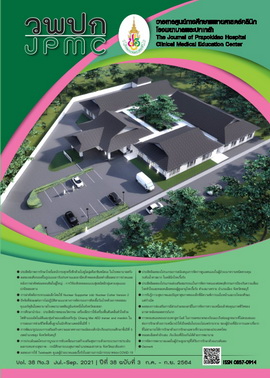Factors Associated with Non - Compliance Regarding Tuberculin Skin Test among Nurses in Tertiary Hospital, Songkhla, Thailand
Main Article Content
Abstract
BACKGROUND: The risk of tuberculosis infection in nurses is generally higher than those of the general population. Therefore, participation in a Tuberculosis (TB) screening program is necessary. However, participating rate of nurses for screening using the Tuberculin skin test (TST) in Songklanagarind Hospital was generally low.
OBJECTIVES: To assess the proportion and factors associated with non - compliance regarding TST screening among nurses in a tertiary hospital, Songkhla, Thailand.
METHODS: This cross - sectional study evaluated the factors associated with non - compliance to TST screening among nurses in a tertiary hospital in Songkhla using an online questionnaire.
RESULTS: Of the 165 nurses who participated in the questionnaire survey, 69% were non-compliant with the TST screening program. Factors associated with the non - compliance were younger age (p = 0.02), short work experience (p = 0.006), and active follow - up for missed any step of TST screening (p = 0.03). From multiple logistic regression, factors associated with non - compliance were age, perceiving that TST screening was an appropriate screening for TB, concerns of being in close contact to TB, having a history of contact with patients or co - workers with known pulmonary TB, active follow - up for missing TST screening, information about advantages and disadvantages of TST screening, long screening time, and supervisor support.
CONCLUSIONS: The proportion of non - compliance for the TST screening program was 69%, associated with young age, short work experience, concerns of being in closed contact with TB, having a history of contact with patients or co - workers with known pulmonary TB, active follow - up for missing TST screening, information about advantages and disadvantages of TST screening, long screening time, and supervisor support. Emphasizing TST screening for new young nurses, improving supervisor’s support, shortening the waiting time for screening test, and evaluating perception toward TST screening after giving information about TST screening will help improve compliance to TST screening.
Article Details
References
World Health Organization. Tuberculosis (TB) [Internet]. 2020[cited 2021 Jan 18]. Available from: https://www.who.int/news-room/fact-sheets/detail/tuberculosis
World Health Organization. Global tuberculosis report 2020 [Internet]. Geneva: WHO; 2020. Chapter 4; TB disease burden. [cited 2021 Jan 18]. Available from: https://apps.who.int/iris/bitstream/handle/10665/336069/9789240013131-eng.pdf
Ministry of Public Health. TB situation in Thailand [Internet]. Nonthaburi: Bureau of TB, Department of Disease Control; 2019. [cited 2021 Jan 17]. Available from: https://www.tbthailand.org/download/Factsheet_TB.pdf
Glaziou P, Sismanidis C, Floyd K, Raviglione M. Global epidemiology of tuberculosis. Cold Spring Harb Perspect Med [Internet]. 2015 [cited 2021 Jan 16]; 5(2): a17798. Available from: https://www.ncbi.nlm.nih.gov/pmc/articles/PMC4315920/
Narasimhan P, Wood J, MacIntyre CR, Mathai D. Risk factors for tuberculosis. Pulm Med [Internet]. 2013 [cited 2021 Jan 16]; 2013:828939. Available from: https://www.ncbi.nlm.nih.gov/pmc/articles/PMC3583136/
Boonmephong K. Zero TB in health care workers [Internet]. Nonthaburi: Department of Disease Control; 2017. [cited 2021 Jan 16]. Available from: http://envocc.ddc.moph.go.th/uploads/Menu/commu/081160/8.5.pdf
Pope AM, Snyder MA, Mood LH. Nursing health, & environment: strengthening the relationship to improve the public's health [Internet]. Washington DC: National Academies Press (US); 1995. Chater 3; Nursing Practice. [cited 2021 Jan 16]. Available from: https://www.ncbi.nlm.nih.gov/books/NBK232401/
Auguste P, Madan J, Tsertsvadze A, Court R, McCarthy N, Sutcliffe P, et al. Identifying latent tuberculosis in high-risk populations: systematic review and meta-analysis of test accuracy. Int J Tuberc Lung Dis 2019;23(11):1178–90.
Arias AF. Mantoux versus immunoferon-gamma test for diagnosis of latent tuberculosis infection in TB patient contacts. Aten Primaria 2011;43:18–25.
Taubman D, Titler N, Edelstein H, Elias M, Saliba W. Providing detailed information about latent tuberculosis and compliance with the PPD test among healthcare workers in Israel: a randomized controlled study. J Epidemiol Glob Health 2013;3:253–60.
Joseph HA, Shrestha-Kuwahara R, Lowry D, Lambert LA, Panlilio AL, Raucher BG, et al. Factors influencing health care workers’ adherence to work site tuberculosis screening and treatment policies. Am J Infect Control 2004;32:456–61.
Nayak S, Acharjya B. Mantoux test and its interpretation. Indian Dermatol Online J [Internet]. 2012 [cited 2021 Jan 24];3(1): 2–6. Available from: https://www.ncbi.nlm.nih.gov/pmc/articles/PMC3481914/
Meireles JM, Gaio R, Duarte R. Factors influencing tuberculosis screening in healthcare workers in Portugal. Eur Respir J 2015;45:834–8.
Becker MH. The health belief model and sick role behavior. Health Education Monographs 1974; 2:409–19.
Hill AB. The environment and disease: association or causation? 1965. J R Soc Med 2015;108:32-7.

